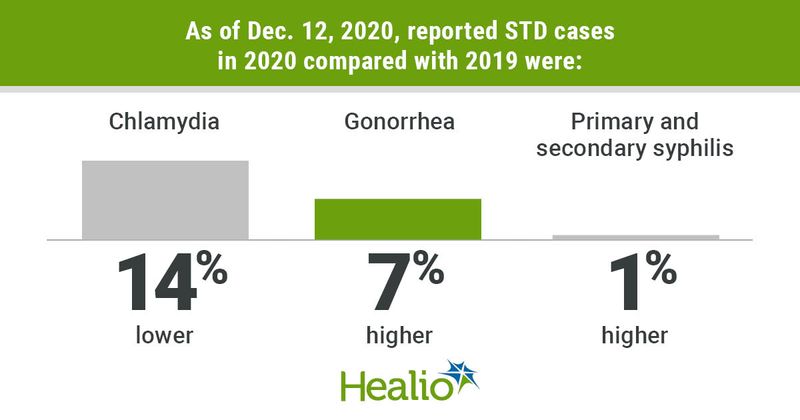CDC data show resurgence of STDs after pandemic-related decline
STDs resurged in the United States by the end of 2020 following a decline in reported cases of chlamydia, gonorrhea and syphilis in March and April during the first peak of COVID-19, according to a new report.
The U.S. recorded a record number of STD cases for 6 consecutive years through 2019, but pandemic-related disruptions to STD testing — among other factors — caused a dip in cases during the early months of the pandemic in 2020.

“When a national emergency declaration was issued for the COVID-19 pandemic on March 13, 2020, states enacted various prevention measures such as stay-at-home orders, the closing of nonessential businesses, and flexible telework policies in the workplace to stem the COVID-19 spread,” Melissa Pagaoa, MPH, an epidemiologist in the CDC’s National Center for HIV/AIDS, Viral Hepatitis, STD and TB Prevention, and colleagues wrote in Sexually Transmitted Diseases.
“These measures potentially affected STD case reporting in several ways, including reduced STD-related screening and care opportunities from temporary clinic closures, changes in sexual behaviors related to social distancing, and decreases in case investigations due to reductions in state and local health department staff,” they wrote.
To assess changes in reported STDs during the pandemic, Pagaoa and colleagues compared the weekly number of reported nationally notifiable STDs in 2020 with that of 2019. According to the study, they reviewed cases of chlamydia, gonorrhea and primary and secondary syphilis reported to the U.S. National Notifiable Disease Surveillance System in 2020. For each STD, they compared the number of 2020 cases reported for a given Morbidity and Mortality Weekly Report (MMWR) week to the number of 2019 cases reported in the same week, expressing 2020 cases as a percentage of 2019 cases.
Overall, they found that cumulative cases of chlamydia were 14% lower in 2020, gonorrhea 7% higher and syphilis 1% higher. According to the study, during MMWR weeks 1 to 11 (Dec. 29, 2019 to March 11, 2020), the weekly number of cases of STDs reported in 2020 as a percentage of the cases in the same week in 2019 were similar. However, 2020 numbers were much lower than 2019 numbers in week 15, or the week of April chlamydia, 49.8%; gonorrhea, 71.2%; and syphilis, 63.7%.
As of week 50, the 2020 cumulative totals compared with those of 2019 were 14% lower for chlamydia, 7.1% higher for gonorrhea and 0.9% lower for P&S syphilis. Pagaoa and colleagues said the 2020 numbers for gonorrhea and syphilis are on track to match and surpass 2019 totals.
“Clearly, the COVID-19 pandemic has introduced uncertainty and difficulty in interpreting the 2020 case counts. The case reports reported in the nonpandemic years of 2018 and 2019 highlight the striking and anomalous nature of the 2020 drop in STD case reports,” the authors wrote. “While the introduction of vaccines have decreased COVID-19 cases and deaths, the effects of the protracted pandemic may impair our ability to obtain an accurate picture of the STD epidemic in the U.S. beyond 2020.”
